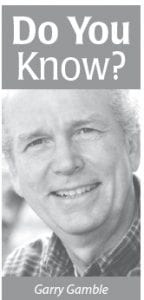After surviving Y2K and the much- ballyhooed transition into the 21st century, my wife Renée, and I traveled to the Chamonix region in France to sequester ourselves in a quaint alpine chalet perched high in the French Alps.
Spending the better part of an afternoon traversing the narrow mountain roads, we eventually arrived at our modest villa only to find the owners industriously occupied at the foot of a towering tree.
Noting our arrival, they abandoned the task at hand and turned their attention toward their newly arrived guests.
I extricated my six-foot-plus frame from the European sub-compact rental car and unfolded my limbs as the group of French gentlemen advanced with the customary congenialities one comes to expect from a French host: “Bonjour Madame and Monsieur.”
Beginning to feel the blood once again reach the outer layer of my cerebral cortex, I became curious and asked what they were up to?
The only fellow who understood English, responded in “Frenchglish,” “Oh, we were attempting to trim branches to keep the tree from toppling over in the winds and to let more sunshine reach the chalet. We had to stop, however, because our ladder doesn’t go any higher. We will have to wait until we can bring in the right equipment.”
Whether it was the onset of altitude sickness or just my usual quest for adventure, I offered to help.
“Oh no!” the Frenchman assured – hands gesturing – “You’re our guests.”
“No, I’m up for this,” I blurted. (After all, how often does one get the opportunity to scale an ancient alpine tree perched precariously on the precipice of oblivion, swaying in fickle gusts of raw mountain air, at an altitude few trees in the world experience?)
“Do you have another hank of rope I could use to make a Swiss harness?” I inquired. At the mention of harness, he extended his arms, as if to offer a blessing, and informed me they had a harness, “just didn’t know how to use it.”
That was all I needed to hear. “Get the harness,” I discreetly directed as I headed for the tree to study my route for sacred ascension.
As I began pruning upper canopy limbs, our French host commented to Renée, above the whining of the chainsaw, “Ah, profess ion-ale!”
Renée politely corrected, “No. Adventurer!” – Which I believe in French is interpreted as “out of one’s tree”!
While the arbor work may have appeared somewhat routine, it stood out in my mind as memorable; a once-in-a-lifetime experience.
Consider, before Hannibal famously crossed the Alps with a herd of elephants, or Napoleon navigated an Alpine mountain pass with an army of 40,000, ancestors of the tree I was harnessed to were pushing their way through the same soil.
How is it that some trees survive the harshest of environments while others struggle to keep their “feet” firmly planted in the ground?
Mary Knudson, who teaches health and science writing at Johns Hopkins School of Medicine, asked tree experts to explain the science behind falling trees: David R. Foster, director, Harvard Forest at Harvard University and Kevin T. Smith, a plant physiologist with the U.S. Department of Agriculture Forest Service, weighed in.
“One main reason trees topple is the phenomenon known as ‘windthrow,’ which uproots a tree. The tree trunk acts as a lever and so the force applied to the roots and trunk increases with height,” says Foster. “Taller trees are more susceptible to windthrow.” Foster explains how the different parts of a tree impact its survival: “Tree species vary in characteristics that influence their susceptibility to breakage and uprooting: the strength of their wood (controls breakage), the depth and strength of their roots (controls uprooting) and the shape of their crowns (branch arrangement) determines how much wind they intercept.”
Smith adds, “When trees become stand-alones they become more vulnerable to strong weather elements such as wind as they lose the physical protection of surrounding trees that keep them from bending very far and breaking.”
Dieter Neth, in neighboring Switzerland, responded to the question: “Do trees have a bigger network of roots than branches?”
“Usually, it is said that a tree has about as much root material as it has shoot material, meaning that what you see above ground is what you would have below. In mountainous regions, trees often grow on a thin veneer of poor soil that covers bare lime rock. When these trees fall you can see they were not able to pry sufficiently deep roots into the rock and became unstable.”
As our newfound friends in France understood, trees that form large crowns have to be pruned regularly to keep them balanced.
So, let me sum this up by drawing parallels between healthy trees and healthy governance:
Those that govern should maintain a “healthy root system” – adequate funding to support the “canopy” (facilities, programs, and services they provide).
When the “canopy” exceeds the funding (healthy root system), it’s time to prune.
Guard against “stand-alones” that make us more vulnerable. When traditional funding sources decline or go away altogether, it’s time to cut back.
Until the day money really does start growing on trees, it would be wise for those entrusted with decisions related to local governance to borrow a lesson from Nature.



Loading Comments